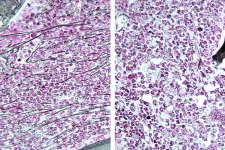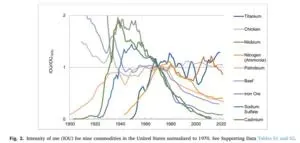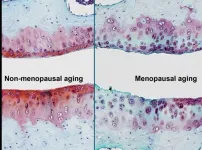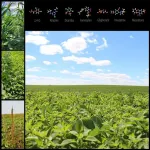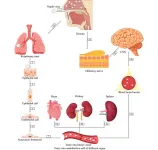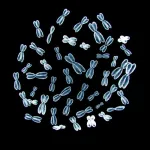(Press-News.org) Two new studies led by researchers at Washington University School of Medicine in St. Louis have identified a possible way to block the progression of several forms of blood cancer using a drug already in clinical trials against breast cancer.
The studies — both conducted in patient samples and animal models — found that inhibiting a protein called RSK1 reduces inflammation and stops the progression of blood cancers called myeloproliferative neoplasms (MPNs) as well as an aggressive form of acute myeloid leukemia (AML). With the RSK1 inhibitor already in clinical testing, the path to expanded use as a treatment for blood cancers likely is accelerated.
One study appears Jan. 16 in Nature Communications. The second is available online in Blood Cancer Journal.
In humans, MPNs can be slow-growing blood cancers that simmer for years. Doctors can monitor the disease and treat symptoms, but there is no reliable way to cure it or slow progression. Patients with MPNs are at high risk of developing a secondary AML that is very aggressive with no effective treatment options.
“Patients with chronic MPNs can live with the disease sometimes for decades, but they’re at increased risk of developing secondary AML, which has a poor prognosis,” said senior author Stephen T. Oh, MD, PhD, an associate professor of medicine and co-director of the Division of Hematology at WashU Medicine. “These patients have no effective medical therapies, so we hope this new drug will help fill that gap in clinical care. At minimum, we’re hopeful this drug can stop the chronic disease from progressing to AML. But the goal is to eliminate the disease and get patients into remission.”
According to Oh, researchers have long been seeking an inhibitor to block MPN progression because current therapies only reduce symptoms caused by the disease, including severe fatigue, night sweats, poor appetite, weight loss, and an enlarged spleen, but do not slow progression of the disease or reduce the risk of it evolving into acute leukemia.
In theory, using RSK1 inhibitors to treat patients with chronic MPNs may improve their health to a point where they could become eligible for a stem cell transplant, which is the preferred therapy for many blood cancers because it can potentially lead to long-term remission. Oh treats patients with MPNs and related blood cancers at Siteman Cancer Center, based at Barnes-Jewish Hospital and WashU Medicine.
In the Nature Communications study, inhibiting RSK1 helped reverse the progression of MPNs in mice, reducing fibrosis, or scar formation, in the bone marrow. Inhibiting RSK1 eliminated up to 96% of cancer in mice after four weeks. It also showed evidence of preventing the chronic disease from transforming into secondary AML.
In the Blood Cancer Journal study, blocking this protein treats a specific form of AML called FLT3-ITD AML that develops directly — without an MPN developing first. This type of AML can be treated with established drugs called FLT3 inhibitors, but the cancer often develops resistance to this treatment over time. Because the RSK1 inhibitor blocks a different pathway, Oh and his co-authors suggested, it could help address this resistance.
The specific RSK1 inhibitor used in both studies, called PMD-026, is given as a pill and is currently in clinical trials as a treatment for breast cancer. Those ongoing studies seek to determine efficacy, and early testing showed trial subjects with metastatic breast cancer have tolerated the drug well with low-grade side effects.
Tracking the path to MPN development – and stopping it
An earlier study by Oh’s group identified a signaling molecule called DUSP6 as an important protein driving the progression of MPNs. Further work identified the downstream signals triggered by DUSP6, and RSK1 stood out as the one they could potentially block with the RSK1 inhibitor already in clinical trials for breast cancer.
The investigational drug PMD-026 is a pan-RSK inhibitor in that it blocks all four versions of the protein — RSK1, RSK2, RSK3 and RSK4. In breast cancer, the evidence suggests that PMD-026 may work by blocking RSK2. If approved by the Food and Drug Administration to treat breast cancer, it would be the first drug on the market to inhibit the RSK family of proteins.
Oh and his team, including Tim Kong, first author of both studies and an MD-PhD student in Oh’s lab, became interested in working with the company that makes the drug — a biotech firm called Phoenix Molecular Designs — when they identified RSK1 as a key driver of several blood cancers and hypothesized that this drug potentially could block its activity as well. The company provided the drug for these studies.
“We are excited about these studies because they highlight RSK1 as a novel therapeutic target for MPNs and AML with a viable strategy for moving an investigational drug into clinical trials in the near future,” Oh said. “There are a few scenarios that we’re considering in designing a future clinical trial. It will most likely be for patients who are beyond the standard therapies that we use for the chronic phase of this disease but are not eligible for stem cell transplantation due to age or overall health.”
###
Kong T, Laranjeira ABA, Letson CT, Yu L, Lin S, Fowles JS, Fisher DAC, Ng S, Yang W, He F, Youn M, Mark K, San Jose A, Liu J, Kim AB, Cox MJ, Fulbright MC, Jayanthan A, Los G, Rentschler SL, Ding L, Sakamoto KM, Dunn SE, Challen GA, Oh ST. RSK1 is an exploitable dependency in myeloproliferative neoplasms and secondary acute myeloid leukemia. Nature Communications. Jan. 16, 2025.
This work was supported by the National Institutes of Health (NIH), grant numbers R01HL134952, T32HL007088, R01HL147978, R01HL163274 and T32HL134635; a Canadian Institutes of Health Research (CIHR) Doctoral Foreign Study Award; and the MPN Research Foundation. Additional support was provided by the Leukemia and Lymphoma Society Translational Research Program; When Everyone Survives Foundation; the Edward P. Evans Foundation; Gabrielle’s Angel Foundation; Stanford Maternal Child Health Research Institute; the Department of Defense, grant number HT94252311008; Hyundai Hope on Wheels; and a Leukemia and Lymphoma Society Scholarship. Additional support was provided by the NCATS Clinical and Translational Sciences Award, grant number UL1 TR002345; the NCI Cancer Center Support Grant, number P30CA91842; and by the Andrew M. and Jane M. Bursky Center for Human Immunology and Immunotherapy Programs.
Kong T, Laranjeira ABA, Letson CT, Yu L, He F, Jayanthan A, Los G, Dunn SE, Challen GA, Oh ST. RSK1 dependency in FLT3-ITD acute myeloid leukemia. Blood Cancer Journal. Nov. 26, 2024.
This work was supported by the National Institutes of Health (NIH), grant numbers R01HL134952 and R01HL147978; a Canadian Institutes of Health Research (CIHR) Doctoral Foreign Study Award; and the MPN Research Foundation. Additional support was provided by the Leukemia and Lymphoma Society Translational Research Program; When Everyone Survives Foundation; the Edward P. Evans Foundation; Gabrielle’s Angel Foundation; and a Leukemia and Lymphoma Society Scholarship.
On both papers, three co-authors are employees of Phoenix Molecular Designs, which provided PMD-026. Co-author Sandra E. Dunn, PhD, founder and CEO of Phoenix Molecular Designs, holds patents on using RSK inhibitors for treatment of cancer.
This content is solely the responsibility of the authors and does not necessarily represent the official views of the NIH.
About Washington University School of Medicine
WashU Medicine is a global leader in academic medicine, including biomedical research, patient care and educational programs with 2,900 faculty. Its National Institutes of Health (NIH) research funding portfolio is the second largest among U.S. medical schools and has grown 56% in the last seven years. Together with institutional investment, WashU Medicine commits well over $1 billion annually to basic and clinical research innovation and training. Its faculty practice is consistently within the top five in the country, with more than 1,900 faculty physicians practicing at 130 locations and who are also the medical staffs of Barnes-Jewish and St. Louis Children’s hospitals of BJC HealthCare. WashU Medicine has a storied history in MD/PhD training, recently dedicated $100 million to scholarships and curriculum renewal for its medical students, and is home to top-notch training programs in every medical subspecialty as well as physical therapy, occupational therapy, and audiology and communications sciences.
END
Drug in clinical trials for breast cancer could also treat some blood cancers
Researchers are working with industry toward a clinical trial for blood cancer patients
2025-01-16
ELSE PRESS RELEASES FROM THIS DATE:
Study identifies mechanism underlying increased osteoarthritis risk in postmenopausal females
2025-01-16
Osteoarthritis (OA) is a condition that disproportionally affects postmenopausal women, and the millions affected can attest to the pain, reduced mobility and diminished quality of life that comes from this disease. While the hormonal changes associated with menopause have long been known to accelerate the development and progression of OA, a deeper understanding of the biological mechanisms that underlie this correlation is crucial for developing effective treatments.
A new study led by researchers at Spaulding Rehabilitation, a member of the Mass General Brigham ...
The material revolution: How USA’s commodity appetite evolved from 1900 to present
2025-01-16
A new study documents the dramatic change in America’s material diet from 1900 to 2020 – ongoing shifts in US commodity consumption patterns with profound environmental, economic, and geopolitical implications.
Published by Iddo K. Wernick of The Rockefeller University’s Program for the Human Environment in the Elsevier journal Resources Policy, the paper details the consumption of 100 key commodities used to build cities, power cars, produce everyday products, and connect people. It charts transformative changes since the start of the 20th century in both absolute ...
Asteroid impact sulfur release less lethal in dinosaur extinction
2025-01-16
Approximately 66 million years ago, the Chicxulub asteroid, estimated to be 10-15 kilometer in diameter, struck the Yucatán Peninsula (in current-day Mexico), creating a 200-kilometer-wide impact crater. This impact triggered a chain reaction of destructive events including a rapid climate change that eventually led to the extinction of the non-avian dinosaurs and in total about 75% of species on Earth. The main culprit is most likely the “impact winter”, which was caused by massive release of dust, soot, and sulfur into the atmosphere, leading to extreme cold, darkness, and a collapse ...
Study shows seed impact mills clobber waterhemp seed viability
2025-01-16
WESTMINSTER, Colorado – 16 January 2025 – Recently published research in the journal Weed Science shows promise for controlling herbicide-resistant weeds in soybean fields by using a seed impact mill at harvest. When installed on a combine, this harvest weed-seed control system (HWSC) mechanically damages weed seeds as they move through the mill to render them non-viable.
Iowa State University Researchers Alexis Meadows and Ram (Ramawatar) Yadav conducted seed impact mill field experiments ...
Study links rising suicidality among teen girls to increase in identifying as LGBQ
2025-01-16
Amid an increase in suicidal behavior among teen girls, new research links this phenomenon to the significant increase in the number of female students identifying as lesbian, gay, bisexual, or questioning (LGBQ).
“This finding suggests that the overall increase in female suicidality is not due to all female students becoming more suicidal, but rather to a larger proportion of students being part of a group that has historically experienced higher rates of suicidal thoughts and behaviors due to social and structural pressures,” says lead author Joseph Cimpian, ...
Mind’s eye: Pineal gland photoreceptor’s 2 genes help fish detect color
2025-01-16
We see color because photoreceptor cones in our eyes detect light waves corresponding to red, green, and blue, while dimness or brightness is detected by photoreceptor rods. Many non-mammalian vertebrates like fish, however, are known to detect color and brightness with the pineal gland, which is part of the brain. An Osaka Metropolitan University research group has further elucidated on how the pineal organ of fish do so.
Previously, the research group led by Professor Akihisa Terakita and Professor Mitsumasa Koyanagi of the Graduate School of Science revealed that ...
Nipah virus: epidemiology, pathogenesis, treatment, and prevention
2025-01-16
Nipah virus (NiV), a zoonotic paramyxovirus with significant human health implications, has garnered considerable attention due to its high fatality rates and potential for human-to-human transmission, posing a global public health threat. Emerging in South and Southeast Asia, NiV is known for its recurrent outbreaks, with a particular focus on its genetic lineages, NiV-MY and NiV-BD, which differ in pathogenicity and transmissibility. The virus, initially isolated in Malaysia in 1998, has since caused outbreaks linked to contact with infected ...
FDA ban on Red Dye 3 and more are highlighted in Sylvester Cancer's January tip sheet
2025-01-16
FDA BANS RED DYE 3 IN FOOD AND INGESTED DRUGS
Citing two studies linking Red Dye 3 to cancer in laboratory male rats, the FDA today revoked authorization for the use of the dye in food and ingested drugs. The move came in response to a 2022 color additive petition. “This is long overdue,” said Tracy Crane, Ph.D., RDN., director of Lifestyle Medicine and Prevention at Sylvester. “Red Dye 3 has been banned for use in cosmetics and topical drugs for more than three decades,” she said. “Yet it gives more than 9,000 foods in the United States their red coloring. These colorful foods and drinks are particularly appealing to young children,” ...
Mapping gene regulation
2025-01-16
KYOTO – An international team of researchers has taken an important step toward understanding how gene expression is controlled across the human genome. A new study has comprehensively analyzed “cis-regulatory elements” (CREs), which are the DNA sequences that regulate gene transcription. This work sheds light on how these elements contribute to cell-specific gene expression and how mutations within them may influence health and disease.
CREs, including enhancers and promoters, are essential for controlling when and where genes are ...
Exposure to air pollution before pregnancy linked to higher child body mass index, study finds
2025-01-16
In a study of more than 5,000 mothers and their children, exposure to air pollution during the three months before pregnancy predicted higher child body mass index (BMI) and related obesity risk factors up to two years of age. Findings from the study, which was supported by the National Institute of Environmental Health Sciences, were published in the journal Environmental Research.
Past research has linked air pollution exposure during pregnancy to a broad range of health problems in children, including respiratory ...
LAST 30 PRESS RELEASES:
How human interaction drove evolution to make bears less aggressive
National Poll: Few parents offer teens guidance on healthy eating during holiday season
Cannabis derivatives could provide new ovarian cancer treatments
Raising strong yeast as a petroleum substitute
Clues to the origin of hot Jupiters hidden in their orbits
Canada’s reduced pledge to Global Fund will impact domestic health
1 in 4 children with major traumatic injuries not cared for in pediatric trauma centres
Duke and Duke-NUS’ joint cross-population research to uncover "East-West" differences in disease and care
Scientists to ‘spy’ on cancer- immune cell interactions using quantum technology breakthrough
Tech savvy users have most digital concerns
Making lighter work of calculating fluid and heat flow
Normalizing blood sugar can halve heart attack risk
Lowering blood sugar cuts heart attack risk in people with prediabetes
Study links genetic variants to risk of blinding eye disease in premature infants
Non-opioid ‘pain sponge’ therapy halts cartilage degeneration and relieves chronic pain
AI can pick up cultural values by mimicking how kids learn
China’s ecological redlines offer fast track to 30 x 30 global conservation goal
Invisible indoor threats: emerging household contaminants and their growing risks to human health
Adding antibody treatment to chemo boosts outcomes for children with rare cancer
Germline pathogenic variants among women without a history of breast cancer
Tanning beds triple melanoma risk, potentially causing broad DNA damage
Unique bond identified as key to viral infection speed
Indoor tanning makes youthful skin much older on a genetic level
Mouse model sheds new light on the causes and potential solutions to human GI problems linked to muscular dystrophy
The Journal of Nuclear Medicine ahead-of-print tip sheet: December 12, 2025
Smarter tools for peering into the microscopic world
Applications open for funding to conduct research in the Kinsey Institute archives
Global measure underestimates the severity of food insecurity
Child survivors of critical illness are missing out on timely follow up care
Risk-based vs annual breast cancer screening / the WISDOM randomized clinical trial
[Press-News.org] Drug in clinical trials for breast cancer could also treat some blood cancersResearchers are working with industry toward a clinical trial for blood cancer patients
